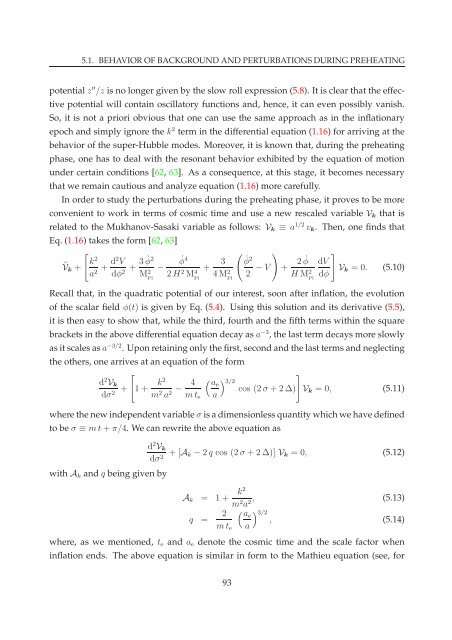PHYS08200605006 D.K. Hazra - Homi Bhabha National Institute
PHYS08200605006 D.K. Hazra - Homi Bhabha National Institute
PHYS08200605006 D.K. Hazra - Homi Bhabha National Institute
You also want an ePaper? Increase the reach of your titles
YUMPU automatically turns print PDFs into web optimized ePapers that Google loves.
5.1. BEHAVIOR OF BACKGROUND AND PERTURBATIONS DURING PREHEATING<br />
potentialz ′′ /z is no longer given by the slow roll expression (5.8). It is clear that the effective<br />
potential will contain oscillatory functions and, hence, it can even possibly vanish.<br />
So, it is not a priori obvious that one can use the same approach as in the inflationary<br />
epoch and simply ignore the k 2 term in the differential equation (1.16) for arriving at the<br />
behavior of the super-Hubble modes. Moreover, it is known that, during the preheating<br />
phase, one has to deal with the resonant behavior exhibited by the equation of motion<br />
under certain conditions [62, 63]. As a consequence, at this stage, it becomes necessary<br />
that we remain cautious and analyze equation (1.16) more carefully.<br />
In order to study the perturbations during the preheating phase, it proves to be more<br />
convenient to work in terms of cosmic time and use a new rescaled variable V k that is<br />
related to the Mukhanov-Sasaki variable as follows: V k ≡ a 1/2 v k . Then, one finds that<br />
Eq. (1.16) takes the form [62, 63]<br />
[<br />
k<br />
¨V 2<br />
k +<br />
a + d2 V<br />
2 dφ + 3 ˙φ 2 ˙φ 4<br />
−<br />
2 M 2 2H 2 M 4 Pl Pl<br />
( )<br />
+ 3 ˙φ2<br />
4M 2 2 −V + 2 ˙φ<br />
HM 2 Pl<br />
Pl<br />
]<br />
dV<br />
V k = 0. (5.10)<br />
dφ<br />
Recall that, in the quadratic potential of our interest, soon after inflation, the evolution<br />
of the scalar field φ(t) is given by Eq. (5.4). Using this solution and its derivative (5.5),<br />
it is then easy to show that, while the third, fourth and the fifth terms within the square<br />
brackets in the above differential equation decay asa −3 , the last term decays more slowly<br />
as it scales asa −3/2 . Upon retaining only the first, second and the last terms and neglecting<br />
the others, one arrives at an equation of the form<br />
[<br />
]<br />
d 2 V k<br />
dσ + 1+ k2<br />
2 m 2 a − 4 ( ae<br />
) 3/2<br />
cos (2σ+2∆) V 2 k = 0, (5.11)<br />
mt e a<br />
where the new independent variableσ is a dimensionless quantity which we have defined<br />
to beσ ≡ mt+π/4. We can rewrite the above equation as<br />
with A k andq being given by<br />
d 2 V k<br />
dσ 2 +[A k −2q cos (2σ+2∆)] V k = 0, (5.12)<br />
A k = 1+ k2<br />
m 2 a2, (5.13)<br />
2<br />
( ae<br />
) 3/2,<br />
q =<br />
(5.14)<br />
mt e a<br />
where, as we mentioned, t e and a e denote the cosmic time and the scale factor when<br />
inflation ends. The above equation is similar in form to the Mathieu equation (see, for<br />
93
















